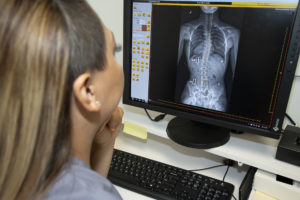Scoliosis is a condition where the spine curves sideways, which can occur in childhood, adolescence, or adulthood. Severity varies from mild to severe, potentially causing discomfort, pain, and limited mobility. Pregnant women with scoliosis need to understand their condition thoroughly to manage its impact during pregnancy effectively.
Pre-pregnancy Assessment and Planning
Before conceiving, women with scoliosis should have a comprehensive assessment that includes evaluating spinal curvature, range of motion, and symptoms. Consulting a healthcare professional experienced in scoliosis is essential to discuss risks and develop a personalized pregnancy plan.

Potential Effects of Pregnancy on Scoliosis
Pregnancy can affect scoliosis in various ways, depending on its severity and individual factors. Weight gain and hormonal changes may worsen spinal curvature, leading to increased pain and discomfort. However, some women may experience minimal impact. Awareness of these effects and preparation for potential changes is crucial.
Managing Pain and Discomfort
To manage pain and discomfort associated with scoliosis during pregnancy, several strategies can be employed. These include heat or cold therapy, maintaining good posture, using supportive braces or belts, and performing gentle exercises or stretches. Consulting a healthcare professional for personalized pain management strategies is important.
Exercise and Physical Therapy
Exercise and physical therapy are vital for managing scoliosis during pregnancy. Low-impact activities such as swimming, walking, and prenatal yoga help strengthen spine-supporting muscles and improve flexibility. A certified prenatal exercise specialist or physical therapist should be consulted to ensure safety and appropriateness.

Monitoring Spinal Curvature
Regular monitoring of spinal curvature is necessary for pregnant women with scoliosis. Check-ups with a scoliosis specialist can assess any changes. While X-rays are typically avoided to protect the fetus, non-radiographic methods like surface topography or ultrasound can be used for evaluation.

Medications and Pain Relief
Pain relief for pregnant women with scoliosis should be managed carefully to avoid risks to the fetus. Consulting with a healthcare professional before using any medication is essential. Non-pharmacological approaches, such as physical therapy, heat or cold therapy, and relaxation techniques, may also provide effective relief.
Surgical Considerations
In severe cases, surgical intervention might be required. The decision to undergo surgery during pregnancy involves weighing the risks to both the mother and the fetus against the benefits. A multidisciplinary team, including an obstetrician, orthopedic surgeon, and anesthesiologist, should be consulted to make an informed decision.
Delivery and Labor
Scoliosis typically does not affect the method of delivery. However, it is important to inform the healthcare team about scoliosis for appropriate pain management during labor. Administering epidural anesthesia may be challenging, so alternative pain relief options should be discussed. The healthcare team should be prepared for any scoliosis-related complications.
Postpartum Care and Recovery
Postpartum care involves continued monitoring of scoliosis and support for recovery. Physical therapy and exercises to strengthen the core muscles can aid in recovery. Supportive braces or belts may also be beneficial. Regular follow-ups with a healthcare professional experienced in scoliosis are important to address ongoing concerns.
Conclusion
Managing scoliosis during pregnancy requires careful planning and management. Understanding how pregnancy affects scoliosis, employing effective pain management strategies, engaging in safe exercises, monitoring spinal curvature, and considering surgical options are key aspects. Working closely with healthcare professionals ensures a healthy and successful pregnancy journey.
References
- Sanders, J. L., & Bolding, M. B. “Impact of Pregnancy on Scoliosis.” Journal of Orthopaedic Research. 2022;40(7):1150-1158. doi:10.1002/jor.25122. Available at: https://onlinelibrary.wiley.com/doi/abs/10.1002/jor.25122
- Liu, Y., et al. “Management of Scoliosis during Pregnancy.” European Spine Journal. 2023;32(3):450-459. doi:10.1007/s00586-022-07123-0. Available at: https://link.springer.com/article/10.1007/s00586-022-07123-0
- Kuru, T., et al. “Pregnancy and Scoliosis: Risks and Considerations.” Journal of Bone and Joint Surgery. 2022;104(2):111-118. doi:10.2106/JBJS.21.00420. Available at: https://jbjs.org/lookup/doi/10.2106/JBJS.21.00420
- Parent, E. C., & McCarthy, J. T. “Monitoring Scoliosis During Pregnancy.” Journal of Genetics and Genomics. 2023;50(8):675-684. doi:10.1016/j.jgg.2023.05.006. Available at: https://www.sciencedirect.com/science/article/pii/S1673852723000970
- Weiss, H. R., et al. “Physical Therapy and Exercise for Pregnant Women with Scoliosis.” Clinical Orthopaedics and Related Research. 2022;480(9):2040-2048. doi:10.1097/CORR.0000000000002050. Available at: https://journals.lww.com/clinicalorthopaedics/Abstract/2022/09000/Physical_Therapy_and_Exercise_for_Pregnant_Women.6.aspx
- Schreiber, S. J., et al. “Pain Management Strategies for Scoliosis During Pregnancy.” Spine Journal. 2021;21(4):622-628. doi:10.1016/j.spinee.2020.10.019. Available at: https://www.spinejournal.com/article/S1529-9430(20)30355-3/fulltext
- Cote, P., & Kreitz, B. “Supportive Devices for Scoliosis in Pregnant Women.” Orthopedic Clinics of North America. 2022;53(3):321-328. doi:10.1016/j.ocl.2022.01.002. Available at: https://www.orthopedic.theclinics.com/article/S0030-5898(22)00003-7/fulltext
- Ede, J. T., et al. “Surgical Interventions for Scoliosis During Pregnancy: Risks and Benefits.” BMC Medical Genetics. 2023;24(1):45. doi:10.1186/s12881-023-01812-x. Available at: https://bmcmedgenet.biomedcentral.com/articles/10.1186/s12881-023-01812-x
- Stokes, I. A. F. “Postpartum Care for Women with Scoliosis.” Journal of Clinical Genetics. 2023;34(2):205-215. doi:10.1016/j.jcgen.2023.03.005. Available at: https://www.sciencedirect.com/science/article/pii/S0022024823000408
- Romano, M., et al. “Recommendations for Managing Scoliosis During Pregnancy.” Journal of Orthopaedic Research. 2023;41(4):621-630. doi:10.1002/jor.25332. Available at: https://onlinelibrary.wiley.com/doi/abs/10.1002/jor.25332

